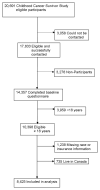Impact of insurance type on survivor-focused and general preventive health care utilization in adult survivors of childhood cancer: the Childhood Cancer Survivor Study (CCSS)
- PMID: 21509774
- PMCID: PMC3433164
- DOI: 10.1002/cncr.25688
Impact of insurance type on survivor-focused and general preventive health care utilization in adult survivors of childhood cancer: the Childhood Cancer Survivor Study (CCSS)
Abstract
Background: Lack of health insurance is a key barrier to accessing care for chronic conditions and cancer screening. The influence of insurance type (private, public, none) on survivor-focused and general preventive health care in adult survivors of childhood cancer was examined.
Methods: The Childhood Cancer Survivor Study is a retrospective cohort study of childhood cancer survivors diagnosed between 1970 and 1986. Among 8425 adult survivors, the relative risk (RR) and 95% confidence interval (CI) of receiving survivor-focused and general preventive health care were estimated for uninsured (n = 1390) and publicly insured (n = 640), compared with for the privately insured (n = 6395)
Results: Uninsured survivors were less likely than those privately insured to report a cancer-related visit (adjusted RR, 0.83; 95% CI, 0.75-0.91) or a cancer center visit (adjusted RR, 0.83; 95% CI, 0.71-0.98). Uninsured survivors had lower levels of utilization in all measures of care in comparison with privately insured. In contrast, publicly insured survivors were more likely to report a cancer-related visit (adjusted RR, 1.22; 95% CI, 1.11-1.35) or a cancer center visit (adjusted RR, 1.41; 95% CI, 1.18-1.70) than were privately insured survivors. Although publicly insured survivors had similar utilization of general health examinations, they were less likely to report a Papanicolaou test or a dental examinations
Conclusions: Among this large, socioeconomically diverse cohort, publicly insured survivors utilize survivor-focused health care at rates at least as high as survivors with private insurance. Uninsured survivors have lower utilization of both survivor-focused and general preventive health care.
Copyright © 2010 American Cancer Society.
Similar articles
-
Childhood Cancer Survivor Study participants' perceptions and knowledge of health insurance coverage: implications for the Affordable Care Act.J Cancer Surviv. 2012 Sep;6(3):251-9. doi: 10.1007/s11764-012-0225-y. Epub 2012 May 17. J Cancer Surviv. 2012. PMID: 22592507 Free PMC article.
-
Children's health insurance status and emergency department utilization in the United States.Pediatrics. 2003 Aug;112(2):314-9. doi: 10.1542/peds.112.2.314. Pediatrics. 2003. PMID: 12897280
-
Evaluation of the association between health insurance status and healthcare utilization and expenditures among adult cancer survivors in the United States.Res Social Adm Pharm. 2023 May;19(5):821-829. doi: 10.1016/j.sapharm.2023.02.005. Epub 2023 Feb 20. Res Social Adm Pharm. 2023. PMID: 36842898
-
Caesarean section in uninsured women in the USA: systematic review and meta-analysis.BMJ Open. 2019 Mar 3;9(3):e025356. doi: 10.1136/bmjopen-2018-025356. BMJ Open. 2019. PMID: 30833323 Free PMC article.
-
Perspectives on Virtual Care for Childhood Cancer Survivors in Non-Metropolitan Areas during the COVID-19 Pandemic.Curr Oncol. 2023 Sep 1;30(9):8111-8116. doi: 10.3390/curroncol30090588. Curr Oncol. 2023. PMID: 37754503 Free PMC article. Review.
Cited by
-
In Low-Income Latino Patients, Post-Affordable Care Act Insurance Disparities May Be Reduced Even More than Broader National Estimates: Evidence from Oregon.J Racial Ethn Health Disparities. 2017 Jun;4(3):329-336. doi: 10.1007/s40615-016-0232-1. Epub 2016 Apr 22. J Racial Ethn Health Disparities. 2017. PMID: 27105630 Free PMC article.
-
Age-dependent changes in health status in the Childhood Cancer Survivor cohort.J Clin Oncol. 2015 Feb 10;33(5):479-91. doi: 10.1200/JCO.2014.57.4863. Epub 2014 Dec 29. J Clin Oncol. 2015. PMID: 25547510 Free PMC article.
-
Impact of the model of long-term follow-up care on adherence to guideline-recommended surveillance among survivors of adolescent and young adult cancers.Cancer Med. 2021 Aug;10(15):5078-5087. doi: 10.1002/cam4.4058. Epub 2021 Jun 15. Cancer Med. 2021. PMID: 34128353 Free PMC article.
-
Access to preventive health care for cancer survivors.Am J Prev Med. 2013 Sep;45(3):304-12. doi: 10.1016/j.amepre.2013.04.021. Am J Prev Med. 2013. PMID: 23953357 Free PMC article.
-
Prevalence and correlates of skin examination among ethnically diverse young adult survivors of childhood cancer.Cancer Med. 2023 Apr;12(7):8557-8566. doi: 10.1002/cam4.5520. Epub 2022 Dec 9. Cancer Med. 2023. PMID: 36495004 Free PMC article.
References
-
- Mariotto AB, Rowland JH, Yabroff KR, et al. Long-term survivors of childhood cancers in the United States. Cancer Epidemiol Biomarkers Prev. 2009;18(4):1033–1040. - PubMed
-
- Oeffinger KC, Mertens AC, Sklar CA, et al. Chronic health conditions in adult survivors of childhood cancer. N Engl J Med. 2006;355(15):1572–1582. - PubMed
-
- Geenen MM, Cardous-Ubbink MC, Kremer LCM, et al. Medical assessment of adverse health outcomes in long-term survivors of childhood cancer. JAMA. 2007;297(24):2705–2715. - PubMed
Publication types
MeSH terms
Grants and funding
LinkOut - more resources
Full Text Sources
Medical


